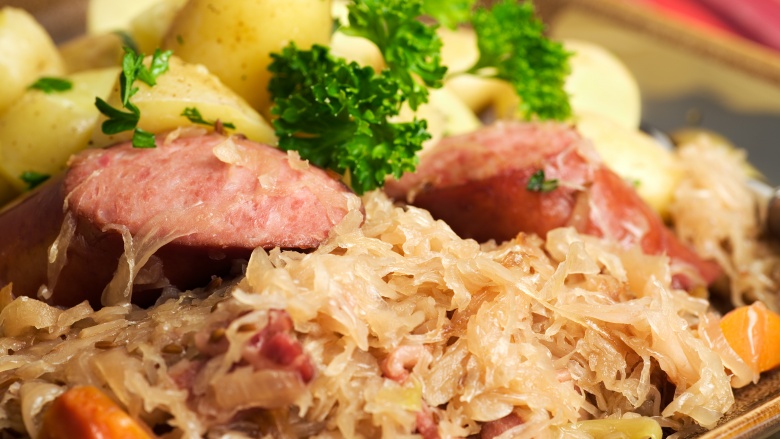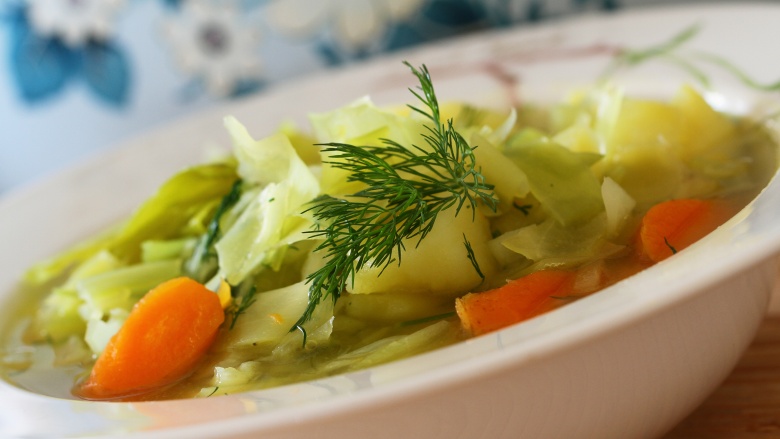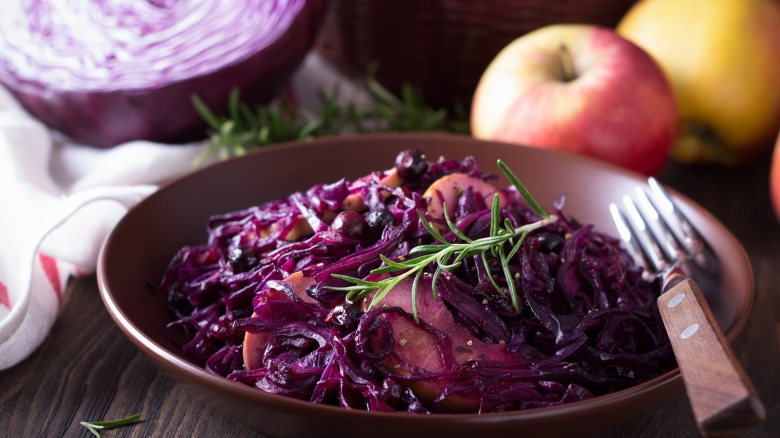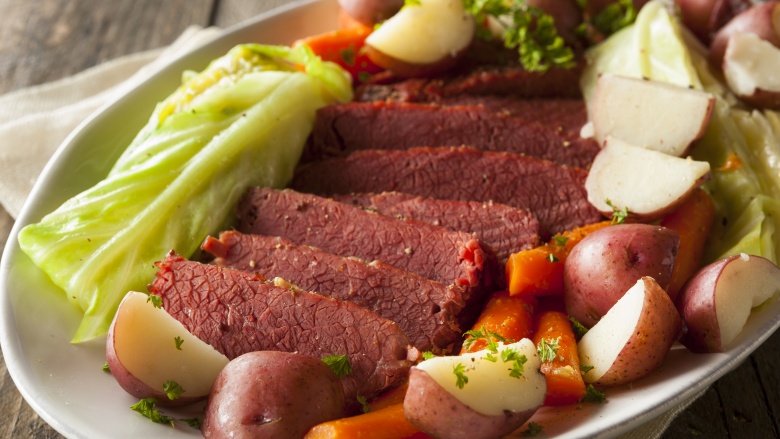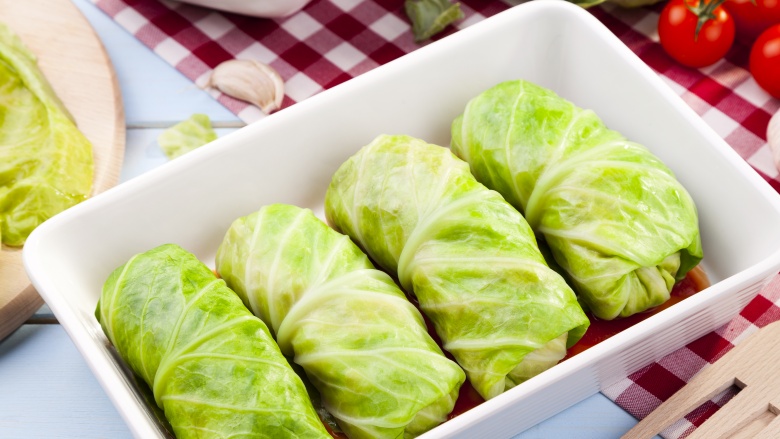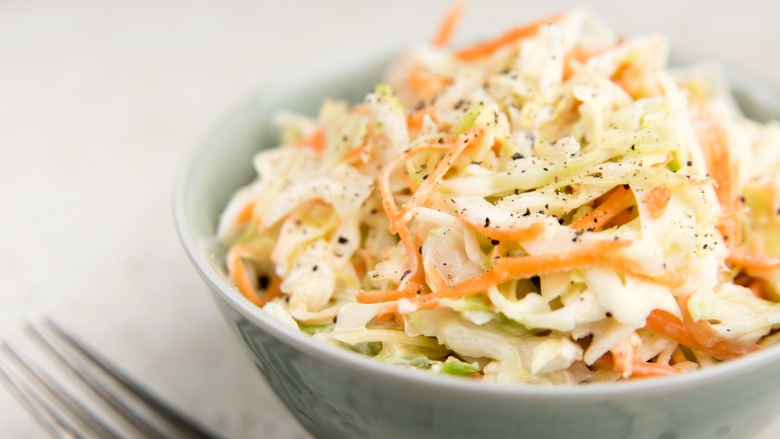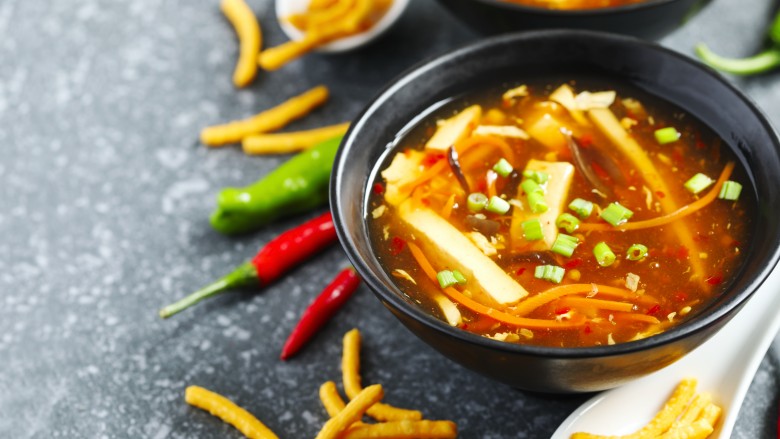9 Interesting Ways You Never Thought To Cook With Cabbage
For a versatile, cruciferous vegetable in the Brassicaceae family, cabbage just doesn't get the respect it deserves, unlike its au courant cousins cauliflower, broccoli, and bok choy. Despite its ho-hum appearance, it can be glamorous and take center stage in delicious recipes that are more than simple poor man's food.
In cold northern climates, cabbage is a favorite vegetable that's relied on for hearty soups, stews, roasts, and main dishes that keep a body warm during frigid winters. In warmer climates, it's often pickled, turned into slaws and salads, and stuffed with enticing fillings. And it's inexpensive, keeps a long time in the refrigerator, is easy to prepare, and is a rich source of soluble fiber and essential nutrients like vitamin B-6, calcium, iron, fiber, and potassium.
Some cultures and cuisines have embraced the cabbage and have an extensive repertoire of mouth-watering ways to cook this leafy green. Here are some interesting ways you can add them to your menu.
Choucroute garni
The French, who we all know are no slouches in the kitchen, have dozens of delicious ways to prepare chou (cabbage). Any place there's a tiny plot for a potager, you'll find at least one variety of cabbage happily growing in neat rows. Cabbage is so tightly woven into French cuisine and culture that it's part of the lingua franca and is used as a term of endearment, as in "mon petit chou" ("my little cabbage," used with children), or "chouchou" ("my darling").
For a treat, consider serving classic choucroute garni. In Alsace, this dish is a favorite that combines the richness of pork and butter with the comforting warmth of slow-cooked cabbage, and who doesn't like a bit of bacon? Get some country sausages (kielbasa can be an excellent substitute), and then simply heat butter and thick-cut bacon in the pan. Add salt and pepper, sliced cabbage, wine, and vinegar. Then cover and let nature do its thing. Once the cabbage finishes braising and the flavors have developed, serve it with the sausages, whip up a light green salad with a Dijon vinaigrette, and pour a glass of dry Riesling. Et voila! You have a gourmet cabbage meal.
Garbure Gasconne
Do you have visions of a toothless evil Madame Defarge spooning out thin, flavorless broth when you hear anyone mention cabbage soup? Put that thought out of your mind. Gascony, a region in southwest France, is famous for its rich but rustic food. They have a way with garbure Gascogne (Gascony cabbage soup) that will make you forget all about Madame Defarge. This garbure is loaded with hearty, flavorful root vegetables like leeks, potatoes, turnips, carrots, parsnips, garlic, and celeriac.
The addition of common regional white beans and rich chicken broth make this a soup you can savor any time of year, but especially when it's blustery outside. To prepare it, saute all of the vegetables in butter, season with salt and pepper and bay leaves, and sweat them until they are just tender. Add the beans and the broth, simmer, and garnish with fresh parsley. If you can resist the temptation, cool the garbure, put it in the fridge for a day or two to let the flavors develop, and then serve it. It will be smashing, and it keeps for about three to four days.
Red cabbage Alsatian style
This recipe for red cabbage Alsatian style is proof this simple vegetable can be the star of a recipe and taste fantastic with just a few other ingredients and spices. Slow cooking lets the natural sugars in the red cabbage interact with the acids and proteins (the Maillard reaction) and transforms its naturally tough, rigid texture into something silky. Plus, slow cooking with vinegar eliminates some of the funkiness that is natural in cruciferous vegetables. This dish can be prepared in a jiffy and is delicious served with braised pork, venison, and other game. To make it, you just cook onions and the shredded cabbage with cloves, cumin, apples, vinegar, and chicken broth and let everything simmer slowly until soft. Then garnish it with butter for a touch of richness and serve. If this inspires you to try other ways to cook red cabbage, here are ten more recipes you can try.
Irish corned beef and cabbage
If, like other Irish-Americans, it's not St. Patrick's Day at your house without a huge pot of corned beef and cabbage on the stove, this recipe is the one you want to serve. It's from Irish cooking expert Darina Allen of Ballymaloe Cookery School fame, and it turns a less than stellar meat into a meal you could serve St. Patty himself. As with any tough cut, brining and slow cooking is the secret to tenderizing the meat and releasing all the flavor trapped in the muscles, fat, and tendons.
Traditionally associated with Cork City in Ireland, this dish has a short list of ingredients, needs almost no prep time, and is easy to cook. The ingredients include the corned brisket of beef, carrots, onions, fresh thyme, parsley, cabbage, and salt and pepper. To prepare this classic, you place everything in a large saucepan, cover with cold water, slowly bring it to a boil, and simmer for two hours covered. Once cooked, use the hearts of the cabbage and onions cut into quarters, and serve it all hot out of the pot with a side of boiled, parsleyed potatoes.
Syrian cabbage mashe
In the Middle East, squash, grape leaves, onions, tomatoes, and cabbage are all vehicles for spectacular stuffed dishes that are just as good to eat as they are beautiful to look at displayed on a platter. The combination of meats, rice, other vegetables, and aromatic spices is so irresistible that you'll want to experiment and try as many recipes as you can.
This recipe is from Syria, which has a long and glorious culinary history influenced by a great ancient kingdom, seafaring trade, the spice trade via the Silk Road, and dozens of other cultures and cuisines. Called cabbage mashe ("mashay"), it's worth every minute of preparation once you taste the combination of beef, rice, cumin, and allspice with the fluffy texture of the cabbage; they're like little bundles of meaty heaven.
The preparation is straightforward and begins with par-cooking the cabbage leaves to soften them and make them pliable enough to fill and roll. Then you can move on to the filling. This is just a simple matter of combining the ground beef in a bowl with melted butter, cooked rice, and spices, then rolling the stuffing into individual cabbage leaves. Place the bundles in a baking dish and bake until the filling is cooked. Remove from the oven and serve with warm pita bread and a side dish of tomatoes and vegetables. That's a complete supper.
Southern coleslaw
Southerners take their coleslaw seriously. No matter which camp you're in — the tangy-sweet vinegar one, the sweet-and-creamy mayo one, or the hybrid made with both vinegar and mayo, there are plenty of recipes out there to try. Finding a good one is much harder. While this recipe isn't cooked, it's the kind of dish every cook should know how to make, and it puts cabbage in the spotlight.
The secret to good flavor in coleslaw is balance. Too much sugar and the slaw tastes like candy; too much vinegar and you won't be able to whistle. For a hybrid, this simple creamy Southern coleslaw recipe hits all the marks and includes celery seed (a staple in Southern slaws, pickles, and potato salad) to give a hint of earthiness to the dressing. If you want a bit more zest, try a tiny amount of Dijon-style mustard; just remember that a little bit goes a long way and it can dominate the taste once it's in the mix.
This recipe is easy to make and should be served the next day so all the flavors have time to develop fully. Shred the green cabbage, carrots, and onions, then mix up the dressing with vinegar, mayonnaise, sugar, celery seed, and salt and pepper. You're looking at a coleslaw that's slap-your-mama good. You can also try variations on the theme and have a lot of fun customizing your dish. For a taste of the other two styles of coleslaw, here is a mayo-only coleslaw and a vinegar coleslaw.
Bubble and squeak
This oddly named British dish gets its bizarre moniker from the sound that it makes as it cooks in the pan. The idea of the dish was always to get rid of all the leftovers that would be otherwise tough to recycle into another meal. While there are so many varieties that it's more a concept than a recipe, the most traditional bubble and squeak contains the most traditional leftovers: potatoes and cabbage. If you want basic, simple, and traditional, it's half cabbage and half potato, mashed together and fried in a pan until it forms a sort of thick pancake.
Of course, there's no need to keep things traditional — it's easy to spice this one up. Fry some bacon in the pan first, and instead of using a bit of butter to keep the cake from sticking, bacon grease will do the trick in a wonderfully tasty way only made better by throwing the bacon in, too. You can also use duck fat or goose fat if you're wanting to stick with a more traditional taste, and you can add in other leftover veg like Brussels sprouts. If you have some leftover carrots in the fridge from your corned beef and cabbage, you can throw those in, too. Really, almost any leftover vegetable works, and that's the heart of the dish. At a time when food was scarce enough that nothing was allowed to go to waste, cooks needed to get creative. It's something we can still experiment with today, and if you top it with a fried egg and some hot sauce, it's a delicious breakfast for a cold, rainy morning.
Hot and sour soup
Chicken soup is great, but it gets a little boring during the long winter months. If you're looking for something that's just as comforting and even easier to make, how about whipping up a cabbage-filled take on hot and sour soup?
The Ordinary Vegan has a super easy recipe for hot and sour soup with cabbage, mushrooms, and noodles, and you can't go wrong with a 20-minute dish from start to finish. Packed full of flavor with vegetable broth, ginger, soy sauce, and chili paste, this dish is delicious and healthy. The recipe calls for a whole head of cabbage, so it's not only a great way to get your vegetables, but it's going to add a whole new flavor to one of the world's most traditional vegetables.
The great thing about adding cabbage to your hot and sour soup is that it's not all you can add, either, and there are lots of variations on this idea. Check out this recipe for hot and sour chicken and cabbage soup that calls for chicken breast, bean sprouts, onion, lemongrass, and a splash of hot pepper flakes. It's the perfect mix of spice, heat, and tangy, and it's the perfect pick-me-up for a chilly winter afternoon, too!
Gyozas
Gyozas are traditional Japanese dumplings similar to Chinese potstickers. They became a part of Japanese cuisine fairly recently, after soldiers who had been stationed in northern China during World War II brought the idea back and modified it a bit. Gyozas are smaller than potstickers (usually only a single bite), and the thinner wrapper means that they have a bit more crispy crunch to them. Cabbage is one of the traditional ingredients, and that means these appetizers are sure to be a hit and that making them is a great cooking project for you and your kitchen helpers. Since they're steamed, it might take some assembly-line work depending on how many you can steam at once, but they're well worth the effort.
One of the most traditional recipes is a pork- and cabbage-filled gyoza, and Serious Eats has a simple recipe for creating these tasty, one-bite appetizers for a light, tasty starter that won't fill you up before the main meal makes it to the table. Add a little chili oil for an extra kick, and in order to keep the cabbage from becoming mushy as it steams, make sure you drain and dry it thoroughly before wrapping it in its little package. If the cabbage is damp when you assemble your gyozas, you run the risk of creating a textural mess.
This starter isn't just forgiving — it's flexible, too. The mild flavor of the cabbage makes it the perfect accompaniment to any kind of meat you want to include. (How about this recipe for prawn gyozas for something a little classy?) Even better, the pre-made wrappers you're tempted to pick up at the store to use are 100 percent traditional. You save a step, and it's a great way to enjoy the final product and the entire process.

